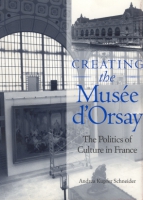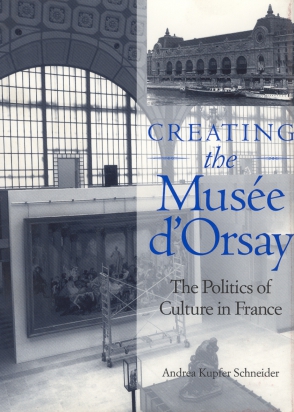Creating the Musée d'Orsay
The Politics of Culture in France
Andrea Kupfer Schneider
The Gare d'Orsay train station, designed by French architect Victor Laloux, opened in Paris in 1900 to much fanfare. In fact, it was so beautiful that the French painter Edouard Détaille felt it would be more appropriate as a museum. Eighty-six years later, after a complex and controversial decision-making process, the French government finally transformed the station into the Musée d'Orsay, now one of the most dramatic and popular museums in Paris. This concise book presents the fascinating history of the creation of the Musée d'Orsay and the battles among the prominent politicians, curators, and historians over the architecture, collections, and concept of the museum.
- Description
- Bio
- Table of Contents
- Subjects
Relying primarily on interviews and contemporary newspaper articles, Andrea Schneider uses her expertise in decision-making analysis to uncover a story that reveals the true power of the curatorial elite. The book focuses on the powerful role of the government in the French art world—a role that may seem remarkable to most Americans. The book also provides insight into the zealous, and often amusing, viewpoints of the French public, art critics, and politicians.
Battle lines were drawn over many questions: Should a nineteenth-century building be saved or destroyed? Should its interior be decorated in a Beaux-Arts style or in a modern design? What period should the museum encompass? Should both academic and avant-garde art be shown in the museum? How should it be organized? Is the museum concerned with the elite or the masses, with high culture or popular culture? Should there be history in an art museum? The story behind the compromises that resulted is fascinating for what it reveals about the interaction of power and culture in French society.
Andrea Kupfer Schneider is Assistant Professor of Law at Marquette University Law School. She is the co-author of Coping with International Conflict (1997) and Beyond Machiavelli: Tools for Coping with Conflict (1994).
Contents
List of Illustrations
Introduction
Part One: Narrative Transformations, Pictorial Elaborations
1. Inventing the Passion in the Late Middle Ages
James H. Marrow
2. The Passion of Mary: The Virgin and the Jews in Medieval Culture
Miri Rubin
3. The Conflicted Representation of Judaism in Italian Renaissance Images of Christ’s Life and Passion
Stephen J. Campbell
4. Ex libera meditatione: Visualizing the Sacrificial Christ in Jerónimo Nadal’s Annotations and Meditations on the Gospels
Walter S. Melion
Part Two: Popular Spectacle, Mass Consumption
5, Coups de Théâtre and the Passion for Vengeance
Jody Enders
6.. Images of the Passion and the History of Protestant Visual Piety in America
David Morgan
7. Realizing the Passion on Screen
Robin Blaetz
8. Jesus of Hollywood
Adele Reinhartz
9 Two Thousand Years of Storytelling About Jesus: How Faithful Is Pasolini’s Gospel to Matthew’s Gospel?
Christopher Fuller
Part Three: Jewish Perspectives
10. Jewish Responses to the Passion Narratives
Marc Saperstein
11. Barnett Newman’s Passion
Lisa Saltzman
Epilogue: A Brief History of Jewish Enmity
David Nirenberg
Notes
Index
Mailing List
Subscribe to our mailing list and be notified about new titles, journals and catalogs.




